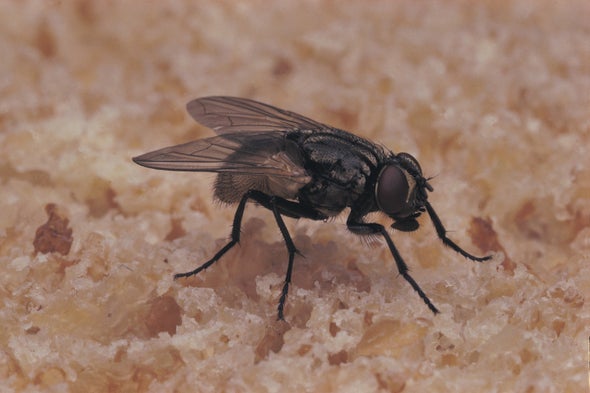(单词翻译:单击)
听力文本
This is Scientific American — 60-Second Science. I'm Christopher Intagliata.
A recent analysis predicts that 40 percent of the world's insect species could go extinct within a couple of decades. The highest death tolls could be among butterflies, moths, bees and dung beetles.
Conspicuously absent from that list are houseflies. Because they may actually do better in a hotter world. "Under a warming scenario you'd have a larger fly population which is able to hang around for a longer period of time." Amy Greer, an epidemiologist and mathematical modeler at the University of Guelph in Ontario.
She says, flies are also more active when it's warm. Meaning more chances to land on your picnic dips.
Greer's student Melanie Cousins, now a doctoral candidate at the University of Waterloo, explains the effect on us: "With this increase in fly population and fly activity, this may lead to more transmission of Campylobacter."
The common foodborne illness, like the flies, fluctuates with the seasons. "So with warmer temperatures Campylobacter will be able to replicate more efficiently."

Cousins modeled both the insect and bacterial trends under different global warming scenarios. And found that the uptick in fly population numbers did not matter much. But if warming truly does increase fly activity, then Campylobacter cases in the Ontario, Canada, area could more than double with a moderate 4 degrees Fahrenheit rise in temperature by 2080. The results are in the journal Royal Society Open Science.
These conclusions do come with many caveats. For instance, the data is generated by a mathematical model, saying this is at least in theory possible. But it does not take into account a possible increase in fly predators, for example. And the researchers haven't actually tested flies landing on food to see if they're dropping off bacteria. And while it has been shown in past studies that flies can carry Campylobacter, it's unclear whether warming temperatures might affect their ability to do so.
Still, the researchers themselves are taking precautions. "I am a little bit paranoid about it personally." "I bought one of those fly screens for picnics to go over the bowls."
Thanks for listening for Scientific American — 60-Second Science. I'm Christopher Intagliata.
参考译文
这里是科学美国人——60秒科学。我是克里斯托弗·因塔利亚塔。
最近一项分析预测,全球40%的昆虫物种可能在未来几十年内灭绝。死亡率最高的物种可能是蝴蝶、飞蛾、蜜蜂和蜣螂。
很明显,家蝇并不在这份名单上。因为家蝇在更热的环境中生命力更强。“在不断升温的情况下,苍蝇种群会增大,其徘徊时间也会增长。”安大略省圭尔夫大学的流行病学家和数学建模师艾米·格里尔说到。
她说,在天气温暖时,苍蝇也会更加活跃。这意味着它们有更多机会落在你的野餐蘸酱上。
格里尔的学生梅兰妮·卡曾斯是滑铁卢大学的博士候选人,她解释了这对我们的影响:“随着苍蝇种群和活跃度的增加,这可能会导致弯曲杆菌更为广泛地传播。”
常见的食源性疾病和苍蝇一样,会随季节变化。“因此,随着温度的升高,弯曲杆菌能更有效地进行复制。”
卡曾斯模拟了昆虫和细菌在不同的全球变暖情景下的趋势。结果发现,苍蝇种群数量增加的影响并不大。但如果气候变暖确实增加了苍蝇的活跃度,那到2080年,气温仅上升4华氏度,就会令加拿大安大略省的弯曲杆菌病例增加一倍以上。这项研究结果发表在《英国皇家学会·开放科学》期刊上。
这些结论的确有许多值得注意的地方。比如,这些数据由数学模型得出,表明这至少在理论上是可能的。但模型并未考虑到苍蝇捕食者的数量也可能增加。研究人员还没有对落在食物上的苍蝇进行测试,查看它们是否会留下细菌。虽然过去的研究表明,苍蝇可以携带弯曲杆菌,但目前尚不清楚气温升高是否会影响苍蝇携带弯曲杆菌的能力。
不过,研究人员自己也在采取预防措施。“我个人对此有点恐惧。”“我买了一个防蚊罩,野餐时用它把碗盖上。”
谢谢大家收听科学美国人——60秒科学。我是克里斯托弗·因塔利亚塔。
译文为可可英语翻译,未经授权请勿转载!
重点讲解
重点讲解:
1. be absent from 不在的;缺席的;
The pictures, too, were absent from the walls.
那些画也不在墙上了。
2. hang around (在某处)等待,闲逛,闲呆着;
Humans, the story goes, realized this was rather useful, and let the least aggressive pups hang around.
传说,人类意识到这种动物很有用,于是允许一些最不具攻击性的小狗在人类居住地周围徘徊。
3. in theory 从理论上说;照理说;
In theory, these machines should last for ten years or more.
从理论上讲,这些机器应能用十年以上。
4. take into account 考虑到;把…计算在内;
Coursework is taken into account as well as exam results.
除考试结果外,课程作业也要计入成绩。


